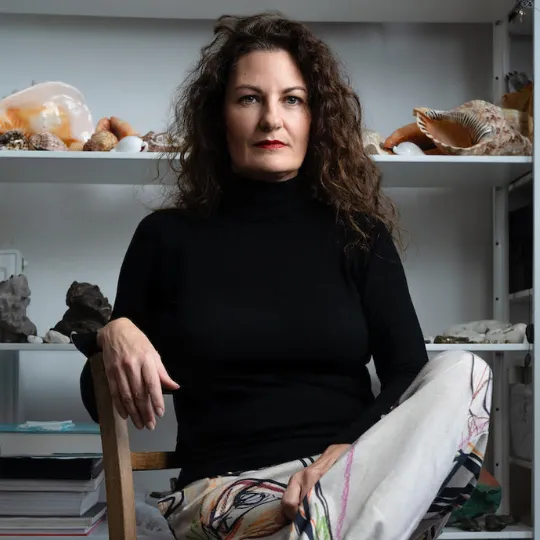Please note: this event has passed
theCOLAB is delighted to present a new commission by artist Kate McMillan, 'The River's Stomach (Songs of Empire)’ at the Strand Lane ‘Roman’ Baths. Weaving together the mediums of sound, video, and objects, McMillan presents imaginary stories based on extensive research on women who have migrated from and to London along the Thames. The resultant work coalesces in this unusual National Trust site, transforming the Baths into a haunting exploration of the residues of colonial violence and the systemic forgetting of women’s stories.
This small National Trust site is hidden in the narrow lane off Surrey Street and is not, in fact, the ‘Roman Bath’ its c.17th owner claimed it to be, in order to profit from the fashion for all things ancient, exemplified by activities such as the Grand Tour. He charged customers from all walks of life to experience the health benefits of cold water submersion, until an MP died of a heart attack in its mysteriously clear waters. In fact, the source of the water source for the Baths was the remaining portion of a cistern built in 1612 from a naturally occurring spring, channelled to feed a fountain in the gardens of the old Somerset House, the building of which was funded by the profits of Empire.
McMillan’s imagination follows the path of the cistern back down to the Thames, the departure and arrival point for the profits of Empire and transforms the ‘Roman Baths’ into ‘The River’s Stomach’. The eel-like form of the Thames is imagined as a digestive tract revealing a silty residue holding traces of stories long forgotten. Women of Empire who arrived, or left England, along the banks of the Thames emerge as projections of 'zombie sirens' who haunt the Roman Baths. McMillan will weave together light, sound, words in a melee of past and present. The work includes a sound commission in collaboration with composer Cat Hope, and includes the voices of sopranos Sarah Dacey and Vera Brozzini, performers Dr Priyanka Basu and Dr Jessica Rapson, and cinematography by Lily Grimes.
About the Artist
Dr Kate McMillan is a renowned artist and academic who has been commissioned on numerous occasions to interrogate histories and places through her multi-disciplinary and collaborative practice, which encompasses sound, light, film and sculpture over her 30 year career. Her bold and engrossing work ‘Never at Sea’ was most recently experienced locally at St Mary-le-Strand Church in 2023 (touring to Salisbury Cathedral) and internationally, including at the Biennale of Sydney and the Trafco Centre for Contemporary Art, Poland.
About The Artist’s Garden
theCOLAB is an independent women-led collaborative laboratory working to bring together people, land, and art by realising artists’ most far-flung and life-affirming work in response to places beyond the confines of the white cube for the public. The Artist’s Garden transformed the neglected half-acre rooftop on Temple tube station into a vast free public sculpture garden to give women artists the opportunity to make their first, early, or greatest outdoor sculptural intervention to promote greater appreciation of their work in public. The annual programme comprises major and smaller scale commissions and theCOLAB/Royal College of Art/Yorkshire Sculpture Park Graduate Award residency. theCOLAB is a registered charity. www.thecolab.art / @thecolab.art
About the ‘Roman Baths’
The Strand Lane 'Roman' Bath is a faux Roman Bath in central London built in the 17th century. The water source for the Bath was the remaining portion of a cistern built, in 1612, to feed a fountain in the gardens of the old Somerset House – then a royal place for King James 1 and his wife, Anne Queen of Denmark, but originally commissioned by the 1st Duke of Somerset. The construction of Somerset Palace, like many other parts of the Crown Estate, was funded by the substantial profits of Empire. By the 19th century, London was the largest centre of business in the world, and the residue of this power was evident across the British capital. The Bath was built in the 1770s by a Mr James Smith, who owned the Georgian Terrace at the front. With the appetite for ancient Rome at its height, typified by activities such as the Grand Tours taking place across Europe, he decided to restore the cistern. He proceeded to charge customers to experience the health benefits of cold water submersion, tricking them into believing it was a genuine Roman bath. It was frequented by people from across all walks of life, and in 1792 the MP William Weddell drowned after having a seizure in the bath. By the end of the 19th century, the Georgian Terrace had changed hands and the faux Roman Baths had fallen into disrepair.
This commission forms part of the programme at The Artist’s Garden which is in partnership with and supported by Fairer Westminster | City of Westminster, King's College London, Nina and Samuel Wisnia, private philanthropists and with kind permission of the National Trust, with thanks to Michael Trapp.
It is part of the conference ‘Taking Place: Women Artists in Public Spaces’ supported by the Department of Culture, Media and Creative Industries at King’s College London, with an AHRS Research Grant, theCOLAB and Nina and Samuel Wisnia, private philanthropists.
EXHIBITION
Address: Strand Lane ‘Roman’ Baths
5 Strand Lane, London WC2R 2NA
Access via Surrey Steps, off Surrey Street, opposite Toklas Bakery or for step free access, from Temple Place/Victoria Embankment.
Opening celebration: Wednesday 21 May 2025, 5–8pm 2025
Exhibition: 22 May - 02 July 2025; from 12:30–5:30pm from Wednesday – Sunday
Closed on 28, 30 and 31 May
FREE and open to the PUBLIC
Event details
Strand Lane ‘Roman’ BathsStrand Lane
Strand Lane, London, WC2R 1AP



